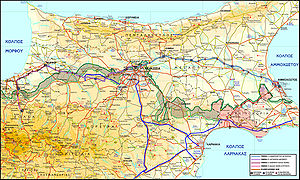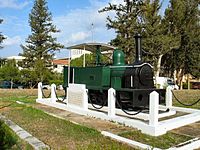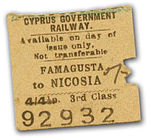- Cyprus Government Railway
-
- This article is part of the history of rail transport by country series
Cyprus Government Railway 
System MapReporting mark CGR Locale Cyprus Dates of operation 1905–1951 Track gauge 2 ft 6 in (762 mm) Length 76 miles (122 km) Headquarters Nicosia The Cyprus Government Railway was a 2 ft 6 in (762 mm) narrow gauge railway network that operated in Cyprus from October 1905 to December 1951. With a total length of 76 miles (122 km), there were 39 stations, stops and halts, the most prominent of which served Famagusta, Prastio Mesaoria, Angastina, Trachoni, Nicosia, Kokkinotrimithia, Morphou, Kalo Chorio and Evrychou. The CGR was closed down due to financial reasons. An extension of the railway which was built to serve the Cyprus Mines Corporation operated until 1974.[1]
Contents
History
Background
When the first British High Commissioner, Sir Garnet Wolseley, arrived in Cyprus in 1878, he was keen to construct a railway on the island but the project did not come to fruition for a long time, due to the uncertainty of the length of the British mandate in Cyprus. In July 1903, Frederick Shelford - on behalf of the Crown Agents - submitted a feasibility study for the construction of a railway line that would originate at Famagusta and terminate at Karavostasi via Nicosia and Morphou, at a total cost of £141,526.[1]
Construction
The proposal was approved in November 1903 and the earthworks began in May 1904; the existing line at Famagusta harbour was extended South to Varosha by 1 mile (1.6 km) and Section 1 [Famagusta-Nicosia, 36 miles (58 km)] was inaugurated on 21 October 1905 by High Commissioner, Sir Charles Anthony King-Harman. The construction of Section 2 [Nicosia-Morphou, 24 miles (39 km)] began in July 1905 and was inaugurated was on 31 March 1907. However, three years later, the Railway was already operating at a loss and so an operation study for the CGR was conducted by Bedford Glasier. The study was published in January 1913 and suggested the construction of the terminus at Evrykhou. So, the construction of Section 3 [Morphou-Evrykhou, 15 miles (24 km)] began in November 1913 and it was inaugurated on 14 June 1915.[2]
Motive Power
Locomotives
Summary of the 12 locomotives: 1x 0-6-0T Class Hunslet Engine Company 2x 4-4-0 Class Nasmyth Wilson and Company 3x 2-6-0 Class Nasmyth Wilson and Company 2x 2-6-2T Class Nasmyth Wilson and Company 4x 4-8-4T Class Kitson and Company [3]
Railcars
Summary of the 9 railcar units: 6x D Wickham & Co 3x Drewry Car Co [4]
Operation and uses
By the time the total 76 miles (122 km) of the CGR had been completed, running costs had spiralled to £199,367, which remained constant throughout the operation period of the line. During the 46 years of its operation, the CGR witnessed various interesting events that marked the modern history of Cyprus, among which were:
- During the Enosis riots in October 1931, 120 yards (110 m) of line were torn up, as the railway was regarded as a symbol of British colonial rule.
- the transportation of Allied troops to and from Famagusta, Nicosia Airport and Xeros during both World Wars.
- It was targeted by the Axis powers during World War II.
- The railway was used for the transportation of a large number of the 50,000 Jewish refugees to Karaolos internment camps, between 1946-1949.
The Cyprus Government Railway was used in a number of ways and served both the colonial authorities and the local population. Principle operations were as follows:
- It served the port of Famagusta, as a freight transfer system.
- It transferred timber from the Troodos Mountains to towns and cities across Cyprus.
- It carried freight, ore and minerals on behalf of the Cyprus Mines Corporation.
- The local railway stations functioned as a place of exchange of goods and services, while some also operated as telephone centres, telegram offices and/or postal offices.
- CGR trains carried mail, which arrived in Famagusta via the Khedivial Mail Line[5] (1912–1939).
The existence of a railway in Cyprus brought many benefits to the population of Cyprus. However, during the first years of its operation, many viewed the Railway more like a spectacle, instead of a means of transportation, which is why they crowded under the bridges to admire it. Overall, the CGR carried 3,199,934 tons of commercial goods and freight and 7,348,643 passengers.
The various stations were designated by large trilingual (Greek, Turkish and English) white signs, while the CGR owned a total of 12 locomotives, 17 coaches and about 100 multi-purpose wagons, 50 of which were purchased from Egypt and Palestine. The CGR employed around 200 people in total.
Railway Stations Halts and Sidings
Harbour Section
- Varosha, Famagusta
- Famagusta Harbour
Section 1
- Varosha, Famagusta
- English Halt
- Enkomi Halt
- Styllos Siding
- Prastio Station
- Gaidhouras Halt
- Pyrga Siding
- Yenagra Siding
- Vitsadha Halt
- Marathovouno Siding
- Angastina Station
- Monastir Siding
- Exometochi Halt
- Epikho Siding
- Trakhoni Station
- Mia Milea Halt
- Kaimakli Siding
- Nicosia Station
Section 2
- Nicosia Station
- Ayios Dhometios Halt
- Nicosia Aerodrome Halt
- Yerolakkos Halt
- Kokkino Trimithia Station
- Dhenia Siding
- Peristerona Siding
- Kato-Kopia Siding
- Argaki Siding
- Morphou Station
Section 3
- Morphou Station
- Nikitas Halt
- Baraji Halt
- Gaziveran Halt
- Pendayia Siding
- Karyotis Junction
- Kalokhorio Station
- Skouriotissa Halt
- Vlasio Halt
- Evrykhou Station
Closure
The line never made a profit and by 1932 the Western terminus station was at Kalokhorio Lefka, while from 1948 onwards it only reached up to Nicosia aerodrome. The ramshackle equipment and the unequal competition with the improved road network led the Government to the decision to definitely terminate the CGR. The last train departed from Nicosia Station at 14:57 on 31 December 1951 and arrived at Famagusta at 16:38. The dismantlement lasted up to March 1953.[2] After an auction was announced in Cyprus Gazette, the 10 of the 12 locomotives, the tracks and part of the rolling stock were sold to the company Meyer Newman & Co, for the price of £65,626. Locomotive 1 was preserved as a monument outside Famagusta Station.
Some wagons were bought by locals, acquiring new and interesting uses, while the equipment was distributed among seven governmental departments. The Stations were either demolished or turned into Police Stations (Angastina[1], Kokkini Trimithia) or Public Works Department warehouses (Famagusta, Nicosia); Morphou Station became a grain storehouse, while at Evrykhou it operated as a sanitary centre and a forest dormitory.
During the Turkish invasion of 1974, most of the remaining installations were knocked down, thus wiping many marks of the Railway. A large part of the Nicosia-Famagusta motorway was built upon the railway track, while wagon 152 was placed in the linear park in Kaimakli, in 1995. In Agios Dometios, part of the railway line recently became a linear park and a multi-purpose centre. Most of the employees were employed in state services and semi-governmental organisations.
See also
References
- ^ a b c Davey, Eileen. Northern Cyprus: A Traveller's Guide. I. B. Tauris. pp. 123. ISBN 978-1-85043-747-5.
- ^ a b Hugh Ballantyne (2007). Cyprus Narrow Gauge. Middleton Press. ISBN 978-1-906008-13-0.
- ^ Cyprus Narrow Gauge Hugh Ballantine ISBN 978-1-906008-13-0
- ^ The Story of the Cyprus Government Railway B S Turner ISBN 0-85298-408-1
- ^ Basic info and timetable images from Khedivial Mail Line http://www.timetableimages.com/maritime/images/kml.htm
- Ο Κυπριακός Κυβερνητικός Σιδηρόδρομος (1905-1951)/The Cyprus Government Railway (1905–1951) by Alexander-Michael Hadjilyra; Nicosia, 2006.
External links
- Roxey Mouldings: Cyprus Government Railway - OO9 loco kits
- [1] CHRONICLE for the Cyprus Government Railway by Alexander-Michael Hadjilyra (in Greek)
- [2] Informative brochure for the Cyprus Government Railway by Alexander-Michael Hadjilyra
- Narrow Gauge image gallery of Cyprus Government Railway
History of rail transport in Europe Sovereign
states- Albania
- Andorra
- Armenia
- Austria
- Azerbaijan
- Belarus
- Belgium
- Bosnia and Herzegovina
- Bulgaria
- Croatia
- Cyprus
- Czech Republic
- Denmark
- Estonia
- Finland
- France
- Georgia
- Germany
- Greece
- Hungary
- Iceland
- Ireland
- Italy
- Kazakhstan
- Latvia
- Liechtenstein
- Lithuania
- Luxembourg
- Macedonia
- Malta
- Moldova
- Monaco
- Montenegro
- Netherlands
- Norway
- Poland
- Portugal
- Romania
- Russia
- San Marino
- Serbia
- Slovakia
- Slovenia
- Spain
- Sweden
- Switzerland
- Turkey
- Ukraine
- United Kingdom
States with limited
recognition- Abkhazia
- Kosovo
- Nagorno-Karabakh
- Northern Cyprus
- South Ossetia
- Transnistria
Other entities Rail transport in Europe Sovereign
states- Albania
- Andorra
- Armenia
- Austria
- Azerbaijan
- Belarus
- Belgium
- Bosnia and Herzegovina
- Bulgaria
- Croatia
- Cyprus
- Czech Republic
- Denmark
- Estonia
- Finland
- France
- Georgia
- Germany
- Greece
- Hungary
- Iceland
- Ireland
- Italy
- Kazakhstan
- Latvia
- Liechtenstein
- Lithuania
- Luxembourg
- Macedonia
- Malta
- Moldova
- Monaco
- Montenegro
- Netherlands
- Norway
- Poland
- Portugal
- Romania
- Russia
- San Marino
- Serbia
- Slovakia
- Slovenia
- Spain
- Sweden
- Switzerland
- Turkey
- Ukraine
- United Kingdom
- Vatican City
States with limited
recognition- Abkhazia
- Kosovo
- Nagorno-Karabakh
- Northern Cyprus
- South Ossetia
- Transnistria
Dependencies
and other territories- Åland
- Faroe Islands
- Gibraltar
- Guernsey
- Jan Mayen
- Jersey
- Isle of Man
- Svalbard
Other entities Categories:- Rail transport in Cyprus
- 2ft 6in gauge railways
- British rule in Cyprus
Wikimedia Foundation. 2010.


